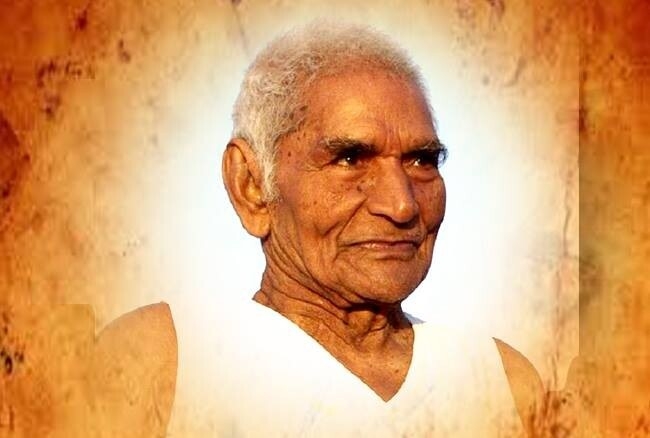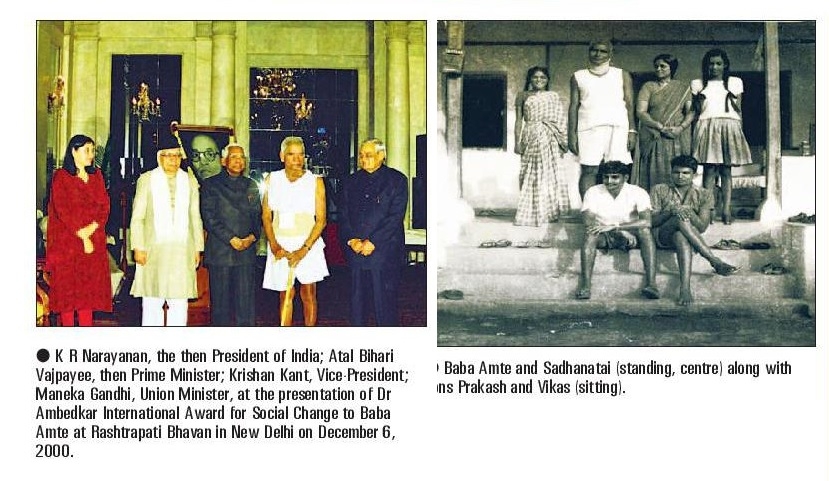MAHAROGI SEWA SAMITI@75 Empowering the disadvantaged
| Date :09-Feb-2025 |

By KARTIK LOKHANDE :
Murlidhar Devidas Amte, popularly remembered today as Baba Amte, founded Maharogi Sewa Samiti (MSS), along with his soulmate Sadhanatai (Indu) and six leprosy patients near Warora in Chandrapur district. The not-for-profit NGO was founded on August 19, 1949. What a fantastic journey it has been for MSS! In these 75 years, it has not only touched millions of lives, but has also ignited the spirit of selfless service among countless many.
M
OST people travel from darkness to light,
but some unfortunate ones are stuck in
darkness because they are unable to
come out on their own. To bring them to
light of empowerment, someone has to
dare to travel from light to darkness. Seventy-five
years ago, a giant of a man did precisely that.
Murlidhar Devidas Amte, popularly remembered
today as Baba Amte, founded Maharogi Sewa Samiti
(MSS), along with his soulmate Sadhanatai (Indu) and
six leprosy patients near Warora in Chandrapur district. The not-for-profit NGO was founded on August
19, 1949. What a fantastic journey it has been for
MSS! In these 75 years, it has not only touched millions of lives but has also ignited the spirit of selfless
service among countless many. More than that, it has
continuously taken up causes that have enriched
humanity. MSS has been relentlessly working
towards the betterment of stigmatised and marginalised people viz. those afflicted with leprosy, visually
impaired, orthopaedically challenged, hearing and
speech impaired, socially and economically backward
rural and tribal populace. From activism to advocacy
of ‘Chancity’ (chance, not just charity) for the
deprived, MSS has matured to take the next leap in
service of humanity.
Today, MSS has three prominent project locations
namely Anandwan, near Warora, Somnath Prakalp,
located in Chandrapur district, and Lok Biradari
Prakalp, Hemalkasa in Gadchiroli district.
The integrated work of the MSS has touched the lives of over
three million disadvantaged people. A blend of medical treatment, compassion, empowerment, and sustained ‘psycho-socio-economic restoration’ is the
speciality of the integrated approach of the social
work model of the MSS. Another salient feature of the
work is that the Amte family has been passing on the
baton of social work from one generation to another.
So, the work started by ‘Padma Vibhushan’ Baba
Amte was taken further by his sons Dr Prakash and
Dr Vikas. Dr Prakash is ably supported by his wife Dr
Mandakini, and Dr Vikas by his wife Dr Bharati. Now,
the next generation is carrying forward the noble
legacy of the humanitarian mission. Kaustubh, Dr
Digant, Aniket are adding newer dimensions to MSS’
work through existing projects.
The journey of 75 years has been a fulfilling one
but not an easy one. Born in an affluent family on
December 26, 1914 in Hinganghat, Wardha, Murlidhar
Amte denounced everything to venture out of light
and embark on an adventurous mission of bringing
the disadvantaged out of darkness.

In the process, he
became ‘Baba’ (father) to many who had lost hope of
life. He evolved as a leader par excellence, champion
of humanitarianism, strong advocate of dignity of
labour and self-reliance, risk-taker, and a world
renowned figure who made friends beyond the geographical borders. As MSS puts it in one of its publications, “Baba didn’t believe in incarnation because
he lived a series of lives in one life.”
In 1962, Anandwan scripted a new chapter when
Baba Amte’s innovative idea of ‘commune’ took the
shape of ‘Muktisadan’. When the leprosy-afflicted
persons’ marriages took place in Anandwan, it
became incumbent to change the residential arrangement. Hence, Baba Amte presented to Swiss Aid
Abroad a unique ‘commune’ project called
‘Muktisadan’. Under this project, each semi-circular
block had three houses -- one at each end of the
semi-circular block faced each other and were occupied by young couples, and the middle one had a
destitute old couple.
The idea entailed these three
couples supporting each other. Swiss Aid Abroad
approved of the idea and offered aid.
What started with Anandwan (forest of joy) for the
leprosy patients who had lost their toes or nose and
hope, the work gradually expanded its scope to
healthcare, education, agriculture and agro-industries,
small and medium scale industrial units, renewable
energy, conservation, architectural innovations.
Anandwan has earned a distinction as Center for
Rural Innovation and Incubation because of a wide
range of activities undertaken over the years. In fact,
several of the ideas generated and implemented in
Anandwan have been replicated in many villages
across Maharashtra such as construction of Nubian
vault houses and man-made lakes among many others.
As it turns a new leaf, Anandwan aspires to
become a ‘Smart Village’. In MSS’ own description,
the SMART (Sustainable, Measurable, Affordable,
Replicable and Technologically advanced) village
model is a holistic approach towards development for
improved quality of life and standard of living for all
our citizens. “We hope to serve as a benchmark for all
villages in the future,” it adds.
Anandwan Mitra Melava: Friends in action
A
s Dr Vikas Amte recalls, more than famous
Indians like Annasaheb Sahasrabuddhe,
Prabhakarpant Korgaonkar, noted litterateurs G
N Dandekar and Yadunath Thatte, people from foreign countries frequented Anandwan to know about
the ongoing work of human empowerment. “Baba
thought of a unique idea of organising ‘Mitra Melava’
(get-together of friends) at Anandwan in 1961, so
that the outside world got acquainted with the leprosy-afflicted people’s determination to become selfsufficient. Another intention was to make the social
and cultural life in Anandwan lively, with emphasis
on exchange of ideas,” says Dr Vikas Amte. The very
first get-together saw stalwarts like Rashtrasant
Tukadoji Maharaj, Dr Shivajirao Patwardhan,
Manohar Diwan, Dada Dharmadhikari, Kamalatai
Hospet, Shankarrao Deo and others in attendance. In
the star-studded event, G N Dandekar’s novel
Anandvanbhuvan was released at the hands of
Raosaheb Patwardhan.
The entire arrangement of the guests was made in
a pandal made of thatch mats. Sadhanatai, Geetabai
Nemade, Sushilabai Kelkar, and Kausalyabai had
prepared well for the get-together by collecting and
sorting the foodgrains for around 1,500 persons a
month in advance.
It was bound to be successful. On
November 22, 1961, a revolutionary chapter was
written when eight leprosy-afflicted couples got
married with the ‘right to companionship’ for the
first time.
Gradually, it became a much-awaited event on
the cultural calendar of not only Maharashtra but
also the country. Several guests came from abroad
too. The legendary litterateurs, music composers,
singers, lyricists, artists, thinkers, political leaders,
social workers, bureaucrats, students and famous
personalities from all walks of life made it a point to
attend the ‘Mitra Melava’. A few prominent names
included Vishram Bedekar, Malatibai Bedekar, P L
Deshpande, Sunitabai Deshpande, Dr Vasantrao
Deshpande, Kumar Gandharva, Vinda Karandikar,
Narhar Kurundkar, B B Borkar, Shriram Lagoo,
Chandrashekhar Dharmadhikari, Principal Ram
Shewalkar... All became ‘brand ambassadors’ of the
humanitarianism promoted by MSS and Anandwan.
The wedding of leprosy-afflicted persons also
became a regular feature. And, who were the people
who sang ‘Mangalashtak’ at these weddings? As Dr
Vikas Amte recalls, they included P L and Sunitabai
Deshpande, Dr Vasantrao Deshpande, B B Borkar,
Kumar Gandharva, Kalapini Komkali! “Will you call
the leprosy-afflicted persons as unfortunates or the
lucky ones?” asks Dr Vikas Amte.
■
A
Baba’s story -- A song of motion
T
he sapling of MSS was planted by Baba and Sadhanatai Amte
in 1949. Before that, a young Murlidhar aspired to become a
doctor but his father wanted him to become a lawyer. Coming
from a rich family, Murlidhar rode horses, went hunting, and played
bridge and tennis at a local club. He drove a car in style, and his car
was decorated with the fur of the leopard he had shot. Suddenly, it
all changed.
It so happened that the well-read Murlidhar saw a man in the
last stage of leprosy. He was terrified as the ailing man was nothing
but a mass of human flesh with two holes in place of a nose, without traces of fingers or toes, with sores. The man was Tulshiram.
The sight of the man changed Murlidhar forever. The initial feeling
of dread was replaced by determination to work for those suffering
from leprosy. For, he realised that loss of strength in feeling kindness and compassion for other humans was more frightening than
losing one’s limbs. For, he realised that loss of confidence because
of leprosy was resulting in loss of hope for life.
“I don’t want to be a leader. I want to be the one who goes
around with a little oil can and offers help when I see a breakdown.”
This quote of Baba Amte sums up what he felt and what
laid the foundation for the work he started. He was so committed to
the upliftment of the leprosy-afflicted persons that he once volunteered to be ‘a guinea pig’ to test a vaccine for leprosy! He offered
to have himself injected with the leprosy bacilli for the purpose of
medical research!! How many people can dare to do that?
After spending years serving the leprosy-afflicted, Baba decided
to adopt an integrated approach to empower them and make them
self-reliant. So, he started roping in the persons who had lost toes
to leprosy, in agriculture. When the first harvest came, the joy of the
leprosy-afflicted knew no bounds. For, they had achieved something. It assured them that life could not rob them of self-confidence. Soon, small and medium scale industries, tricycle workshop,
education to girls with speech and hearing impairment, marriage of
leprosy-afflicted persons... The story went on to blossom into a legend. Lok Biradari Prakalp came up at Hemalkasa when there was
no proper road or electricity supply or telecommunication facility
available there, leave alone healthcare. Dr Prakash and Dr
Mandakini transformed it into a temple of inspiration for countless
many. Like Baba, Dr Prakash also is a recipient of Magsaysay Award.
Youth camp at Somnath is still a craze among the youngsters.
Ashokvan project near Nagpur is now turning a leaf. ‘Padma Shri’ Dr
Prakash Amte, along with another Magsaysay awardee Dr Bharat
Vatwani, Founder Trustee of Shraddha Rehabilitation Foundation,
have come together to help the psychiatrists in Nagpur succeed in
their endeavour to provide better healthcare to mentally challenged
destitutes.
Baba indeed expanded the work into newer areas. His life was a
‘Gatiche Geet’ (song of motion). Hence, when terrorism afflicted
Punjab, Baba Amte dared to take out ‘Bharat Jodo Yatra’ to arouse
the sense of national integration among the discontent sections. He
travelled across the length and breadth of the country from
Kanyakumari to Jammu and was joined by several youths on bicycle
in the mission. Through ‘Bharat Jodo Yatra’, he motivated youth to
take up constructive causes to channelise their energy for positive
interventions. In the later years of his life, Baba associated himself with
‘Narmada Bachao Andolan’ and stayed at Kasravad in Madhya
Pradesh for a few years.
Upon return from Kasravad, he vowed to
stand with the persons likely to be affected due to Inchampalli and
Bhopalpatnam projects. He was friends with Nobel Prize recipient
Dalai Lama and several internationally renowned personalities, but
stayed simple all through, wearing white half-pant and ‘bandi’.
Of course, his outstanding work fetched him many honours
including ‘Padma Shri’ (1971), Jamnalal Bajaj Award (1979),
Magsaysay Award (1985), Welfare of the Disabled (1986), ‘Padma
Vibhushan’ (1986), G D Birla International Award (1988), Gandhi
Peace Prize (2000), Dr Ambedkar International Award for Social
Change (1999), Damien Dutton, Templeton, Right Livelihood awards
among many others. (Photo feature on page 2) ■